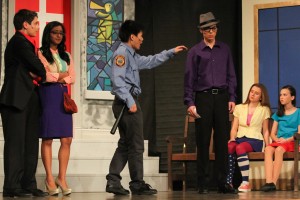William Shakespeare. The Comedy of Errors. Gutenberg.org. Oct. 1998. Web. 24 Aug. 2013.

This is not a precisely review of Shakespeare’s The Comedy of Errors. These are production notes. Hopefully, the reader can still learn some things from this, and perhaps pick up some ideas if he or she is putting on a production of the play.
This was a production for a K-12 school. The cast was made up of students from grades seven through twelve. As with most Shakespeare productions, some speeches were trimmed. Because the audience would include elementary age students, we changed the Courtesan to a Courtier whom Antipholus of Ephesus was trying to bribe. We really had to change very few words to accomplish this.
We were somewhat inspired by an article that a colleague shared about a production of Hamlet that took advantage of the near ubiquitous use of Internet-enabled phones and PDAs in the audience. We felt we could not quite do what that college theater did for a few reasons. One was simply that we did not have the bandwidth at our school to support the potential number of Internet devices in the audience. Another was that the Hamlet version ended up being a sort of improvisational theater. As a director, my challenge was to get the kids to act out Shakespeare, without adding the extra extemporaneous work required by improv.
Our solution was to place a screen on either side of the stage which projected a video, simulated web pages, graphics, and other bits of information. Such things included the fund-raising “Free Aegeon” web site, pictures of grease lamps and iron crows, and an exchange rate table converting Ephesian Marks, Guilders, and Ducats into Dollars, Pounds, Yuan, and Reis.

Instead of getting clowns to act out the story of Aegeon as is often done (we used clowns as entr’actes in our production of J.B. last year), a student made a cartoon video showing Aegeon’s story. That may have been the biggest challenge because the actors could not see the screen, and the actor’s delivery was not always given at the same rate as the pictures on the screen. Still, it helped the audience get into the story.
I saw my job as director to largely explain what was happening and what the lines meant. Once the student actors got that, as much as I could, I let them go. As a result, they came up with lots of appropriate actions to go along with the language themselves. I encouraged them to think Three Stooges, not Laurence Olivier. So the final production was able to reach our broad audience pretty well, from older Shakespeare scholars to elementary age kids who enjoyed the action and silliness. Hey, even older scholars enjoys silliness sometimes.
Timing is important in comedy, and the student actors were able to keep on top of their cues. We had no intermission because the action is fast and the whole play lasted about 80 minutes. We chose modern costumes and a somewhat modern, perhaps timeless, setting. The costumes were virtually all bright primary or Crayola eight colors. This added to the festive, if not specifically comic, tone of the play. The Duke had a black suit, but even he had a fairly bright blue shirt with his black tie. Pinch and her assistant had black robes, but they were unbuttoned to show bright multicolors underneath.
Following many other productions of the play, we included a number of pedestrians who would cross from time to time. So Antipholus of Syracuse says, “None but witches do inhabit here” to a female pedestrian walking by. When Antipholus of Ephesus agrees with Balthazar not to break down his door with a crowbar, the Abbess walks by thus confirming his conscience. Two or three times—always when none of the Antipholi or Dromios are on stage—Aegeon crosses with the jailer in tow begging people for money. He even begs in the audience. Once he goes by while Adriana is railing that her husband “is deformed, crooked, old, and sere,” so she yells at him and he quickly ambles offstage. And at one point as most productions do, we had the two Dromios pass by on either side of an empty frame and act as if they are looking into a mirror. The last two got laughs each performance.
Having said all that, let me share the production notes I wrote for the program. I like to think that this gets to one of the themes of the play. Even in his silliest comedies, Shakespeare had themes. This was more than just a cute entertainment like Menaechmi, the Roman play that inspired Shakespeare. There is a foundation that continues to make it funny today. As Thoreau would say, “Truth alone wears well.”
“He is stark mad!”
“There’s none but witches do inhabit here.”
With all the unusual activity going on in Ephesus, it is no wonder that some citizens think certain people are out of their minds or given over to evil supernatural activity. In The Comedy of Errors, though, it turns out there are no madmen or ghosts. Eventually, the Duke, the Abbess, and everyone else discovers the truth about Antipholus.
Jesus of Nazareth also made pretty extravagant claims about himself. Was he crazy? Some people thought so. Thanks to Freud, many people today are taught that religion is a mental illness. Was he evil? There is a whole body of testimonies saying that miracles done in his name were diabolical. Or was he the One whom he said he was? The historical testimony says that he certainly might have been. After all, rising form the dead is not an ordinary occurrence.
Jesus said, “The truth shall set you free.” (John 8:32) We see in our play how the truth set Antipholus and Aegeon free. So learning about and embracing the truth about Jesus can set you free. Examine his claims for yourself, and ask him to show you the truth.
3 thoughts on “The Comedy of Errors – Production Notes”